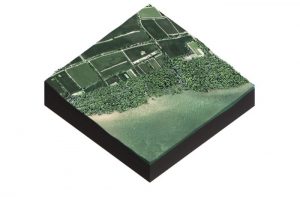Practical Applications
On the right a couple of cases are presented providing some application experiences that can be used as inspiration for future designs.
This section describes the application of the Concept to a practical case. The study area for this application is East Coast Park (ECP), a recreational coastal park in Singapore. This site is selected for the practical application to show the use of the determination flowchart. The additional value of mangroves for a recreational area is not considered, but is probably low.
East Coast Park has been built on reclaimed land, which is subject to coastal retreat since reclamation in the 1970s. Numerous hard structures, mainly headland breakwaters, were constructed to combat these erosion problems.
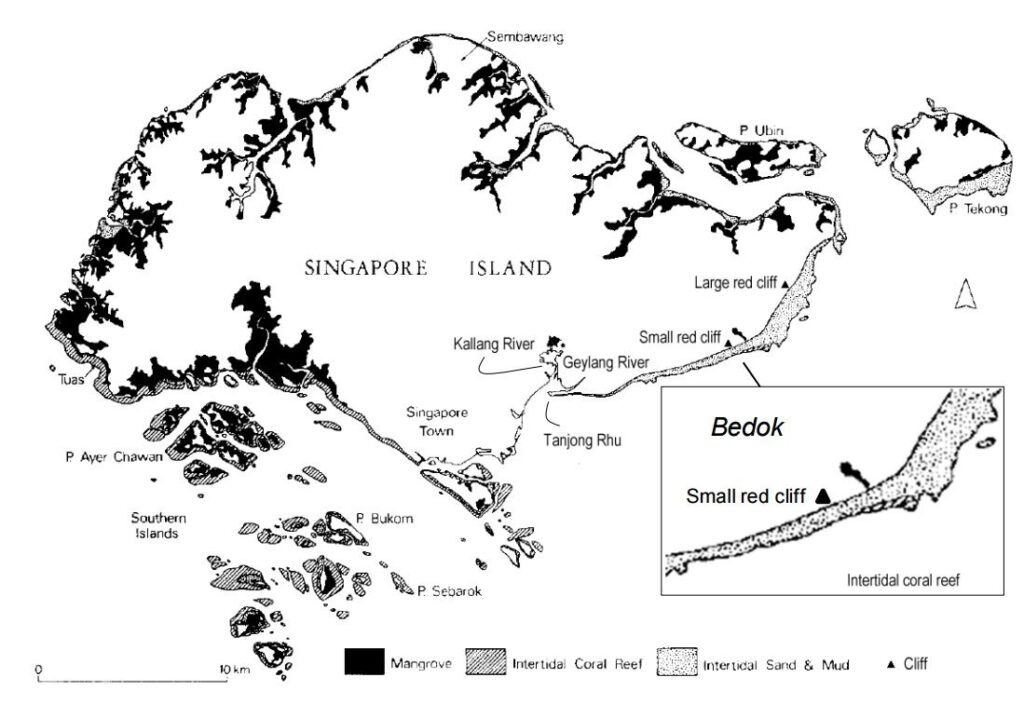
There is an opportunity for a Building with Nature (BwN) approach to mitigate erosion at ECP and enhance biodiversity in the area. Currently, ecosystems like coral reefs, seagrass meadows or mangrove forests are limited or absent at ECP. With a BwN design, a suitable habitat can be created for such an ecosystem. An advantage of a BwN design is that the natural systems component is able to adapt to relative sea level rise.
Currently mangrove forests are not present at ECP. From the figure above it can be derived that no mangroves were present at the old ECP coastline (before reclamation). At that time, the coast was fringed by intertidal sand and mud flats. Presently, beach plants such as sea hibiscus occur at the eastern side of East Coast Park. Sea hibiscus signifies the high water mark and the boundary between salt water penetration and the freshwater system, i.e. the back of the mangrove zone. Propagules of mangrove species frequently strand on the beaches near the high water line, due to the close proximity of other mangrove forests. These propagules are however not establishing because the habitat requirements are presently not met.
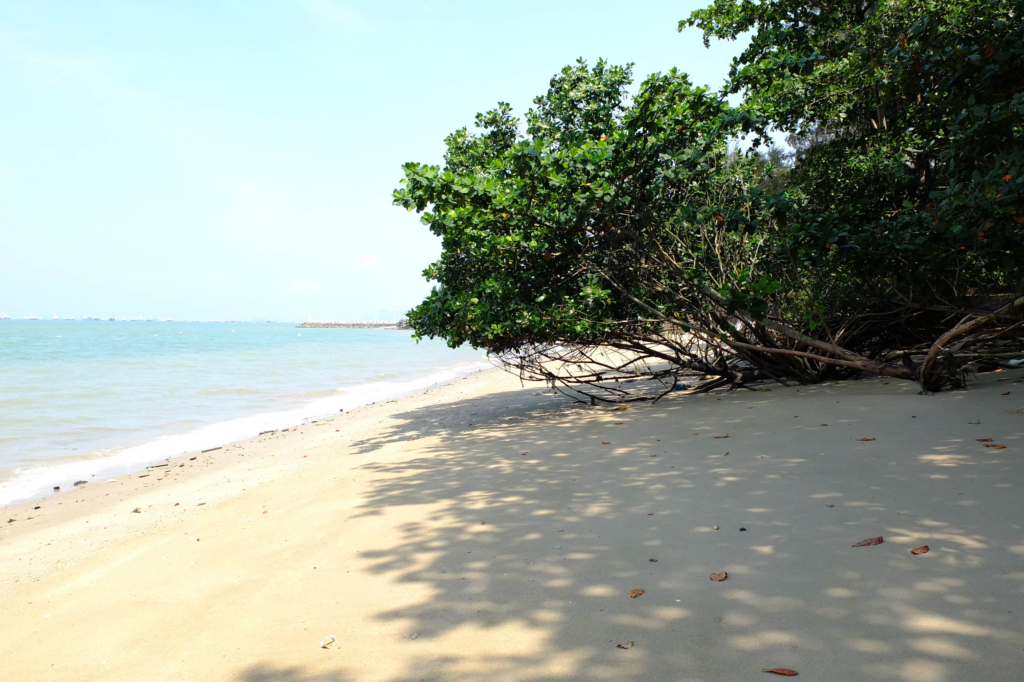
Fill in determination flowchart
Following the flowchart the aim is to find the reason for the absence of mangroves at ECP and to have an indication of whether mangroves can be considered as an ecosystem engineer for a BwN design there. At this moment no detailed design for ECP has been created yet. This provides the opportunity to include the BwN-concept in an early stage of the design phase in such a way that an optimal habitat for mangroves is created. Later in the design process, the possibilities for adaptation of the design will decrease as more aspects have become final and cannot be changed anymore. Yet, the possibility to incorporate mangroves in the final design can be considered in a later stage (using the flowchart).
For each parameter in the determination flowchart, information at the specific project location is needed. The following sources of information can be considered:
- Current state of the ecosystem at the site (occurrence and health of species present)
- Available literature
- Computational modelling
- Data collection (measurements/field work)
The above is hierarchic, based on the amount of effort it usually takes to obtain information from that particular source. Note, however, that this effort can differ significantly from site to site, due to local knowledge, specific circumstances, availability of measuring equipment, etc.
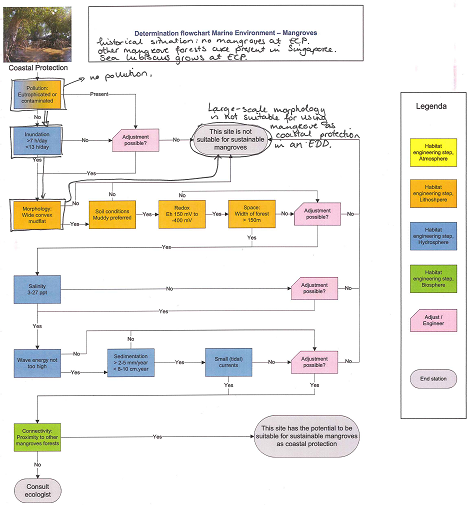
In the following section, the flowchart is discussed from top to bottom to give a description of the reasoning behind the habitat requirements.
Pollution – There is no indication that at present contamination is a problem at ECP, but economical activities, such as industries and shipping/harbours, and run-off from the densely populated area might cause pollution. High Nitrogen load might be an issue, as several drains discharge at the ECP coastline. High nutrient loads pose a problem for matured mangrove trees and are therefore not considered a limiting factor for the germination phase. If high nutrient load were a problem, at least small mangrove trees should be present at ECP. As they are not, pollution is probably not a limiting factor for mangrove establishment.
Inundation – The average tidal range in the area is 2-3m. In combination with the typical erosional beach profiles at ECP, this results in an intertidal zone of approximately 100 m width. The area offers a variety of inundation times and a shallow subaqueos area as the seafloor is sloping downwards. Hence, inundation is not a limiting factor.
Morphology – Mangrove forests can only establish on a wide convex mudflat which gradually dampens wave energy and provides for a wide intertidal flat. Since the coastal profile at ECP is steep, as a result of the land reclamation, the present bathymetry is one of the main reasons for the current absence of mangroves.
Soil conditions – Mangroves flourish in muddy environments (clay and silty soil). For the reclamation, coarse sandy material was placed on top of the original clayey/sandy deposits. The historic deposits are still exposed further offshore. The absence of mud in the intertidal zone, supports the conclusion that the habitat is unsuitable for mangroves. In general, when the coast is not muddy, it is an indication that the hydrodynamic energy might be too high for mangroves. Conclusion: soil conditions at ECP are not suitable for mangroves.
At this point, following the determination flowchart, it leads to the grey text balloon: ‘This site is not suitable for sustainable mangroves’. The large scale morphology (coastal profile and soil conditions) prevents mangroves to grow at ECP, despite propagule supply.
For demonstration purposes, the remaining steps in the flowchart will be followed.
Redox – No measurements or literature of the redox parameter are available. To determine this parameter, field measurements are required. The main purpose of measuring the redox potential is to ensure that anoxic conditions will not limit mangrove rooting.
Space – The coastal profile at ECP is steep and the intertidal area has a width of approximately 100 m. Hence, space for a sustainable mangrove forest, with a pioneer zone, middle zone and back zone, is insufficient.
Salinity – Mangroves need freshwater input. This can be provided by runoff or precipitation. At ECP, no large rivers debouch. The area seasonally receives large amounts of precipitation, directly, via surface runoff and through drains. The geometry of the coastline supports flushing of the freshwater by the tide. Hence, retention times of freshwater, in the area that would potentially support mangroves, are negligible. Conclusion: salinity at ECP might be too high for mangroves.
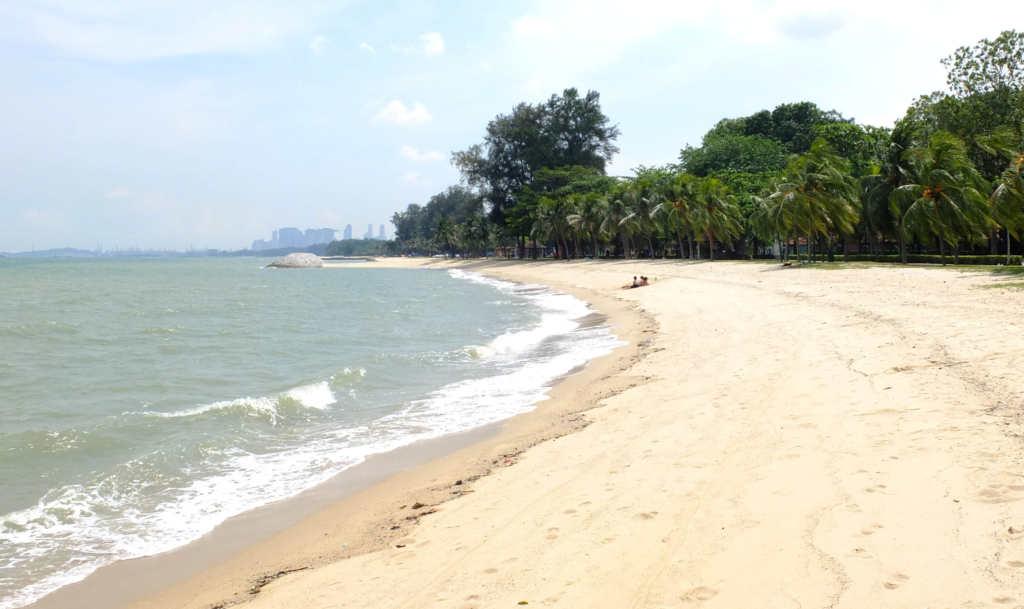
Notice the steep beach slope.
Hydrodynamic energy – A wide convex mudflat can only be maintained when hydrodynamic energy is low. Mature mangrove trees can withstand reasonable amounts of hydrodynamic energy, but the muddy subsoil will erode easily. Mangrove roots do not penetrate deep into the soil (~0.5 m), a few decimeters of erosion can result in uprooting of the tree. The wave climate at ECP is moderate, with waves rarely exceeding 1 m in wave height. This will not limit mangrove establishment at ECP.
Sedimentation – Mangroves mainly occur in tropical intertidal zones. They need enough sedimentation in order to keep up with sea-level rise and subsidence. In general, sedimentation may not be too fast, otherwise it will smother the breathing roots. Since erosion occurs at ECP, continuous sedimentation will probably not limit mangrove establishment.
Connectivity – Proximity to other mangrove forests will supply the propagules and diaspores needed to support a sustainable mangrove ecosystem. Fauna can also migrate easily to the new mangrove spot when distances are not too large. Small crabs and lobsters will cause bioturbation of the soil and prevent anoxic conditions. This all contributes to a healthy and sustainable ecosystem. Proximity to other mangrove forests will increase the chance of success of including mangroves in a BwN design. Elsewhere in Singapore mangrove forests occur. Depending on currents and distance, propagules may arrive at ECP, but this needs to be checked by testing if propagules are found at ECP in the period that mangroves elsewhere in Singapore produce them.
Conclusion
This initial assessment shows that the large scale morphology of ECP in its present state is not suitable for mangrove development. Historical data show that the area has not supported mangroves before, which is a first indication that establishment will be difficult. The area lacks a wide convex mudflat, which is essential for wave damping and space requirements of a sustainable forest. Currently, wave energy is dissipated in a narrow zone. In addition the sediment is sandy, whereas mangroves prefer a muddy soil type and a sheltered location with sufficient tidal through flow. A convex mudflat indicates an accreting coast and a gradual wave attenuation. The salinity is possibly too high for establishment, due to the damming of the Gaylang rivers (reduced outflow) and the short retention time.
Although ECP is not a suitable environment for a sustainable coastal mangrove forest, this does not preclude other ecosystems like seagrass meadows and coral reefs as parts of a BwN development. Coral reefs can be a more attractive alternative (because of recreation values as well).

